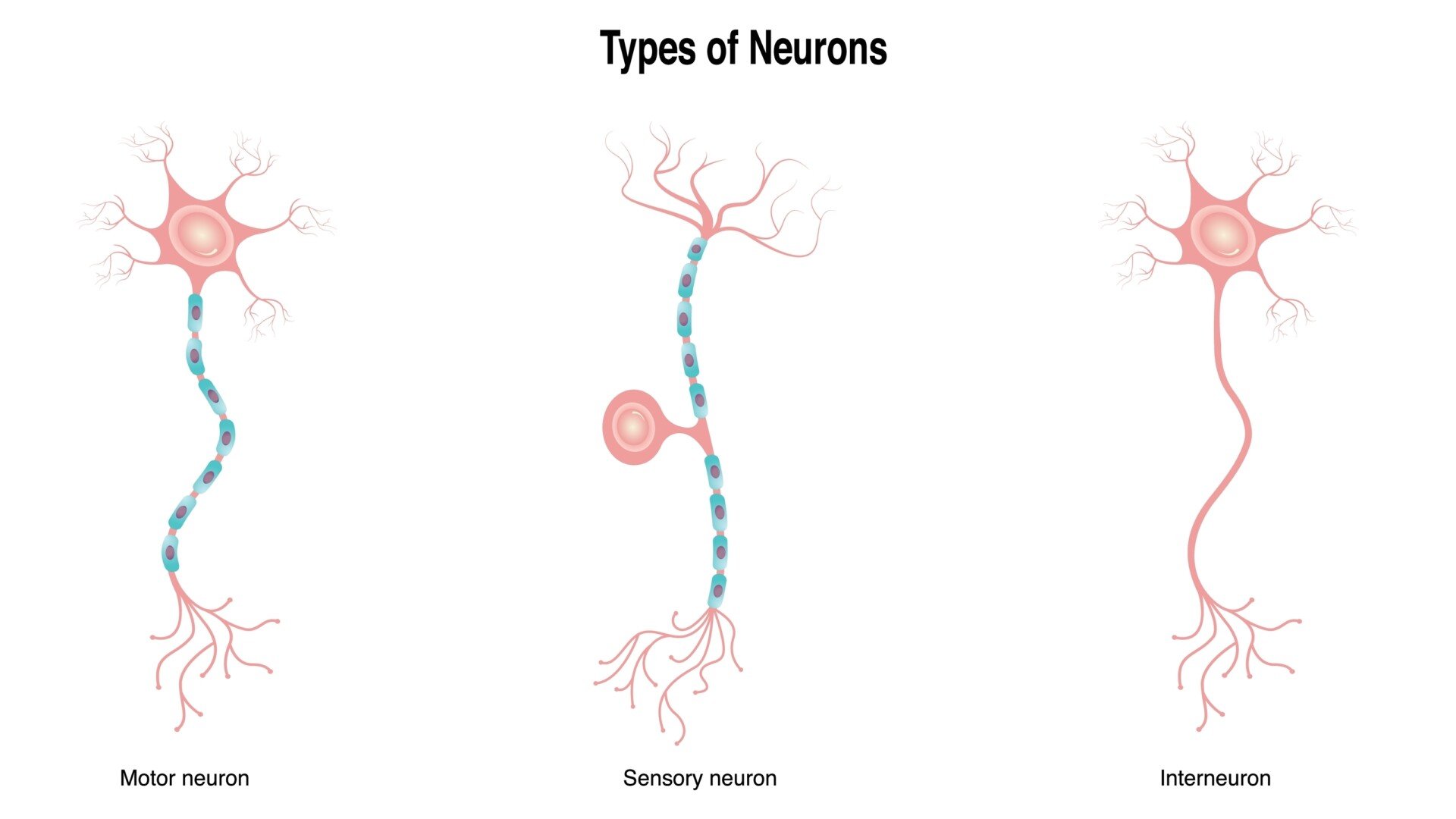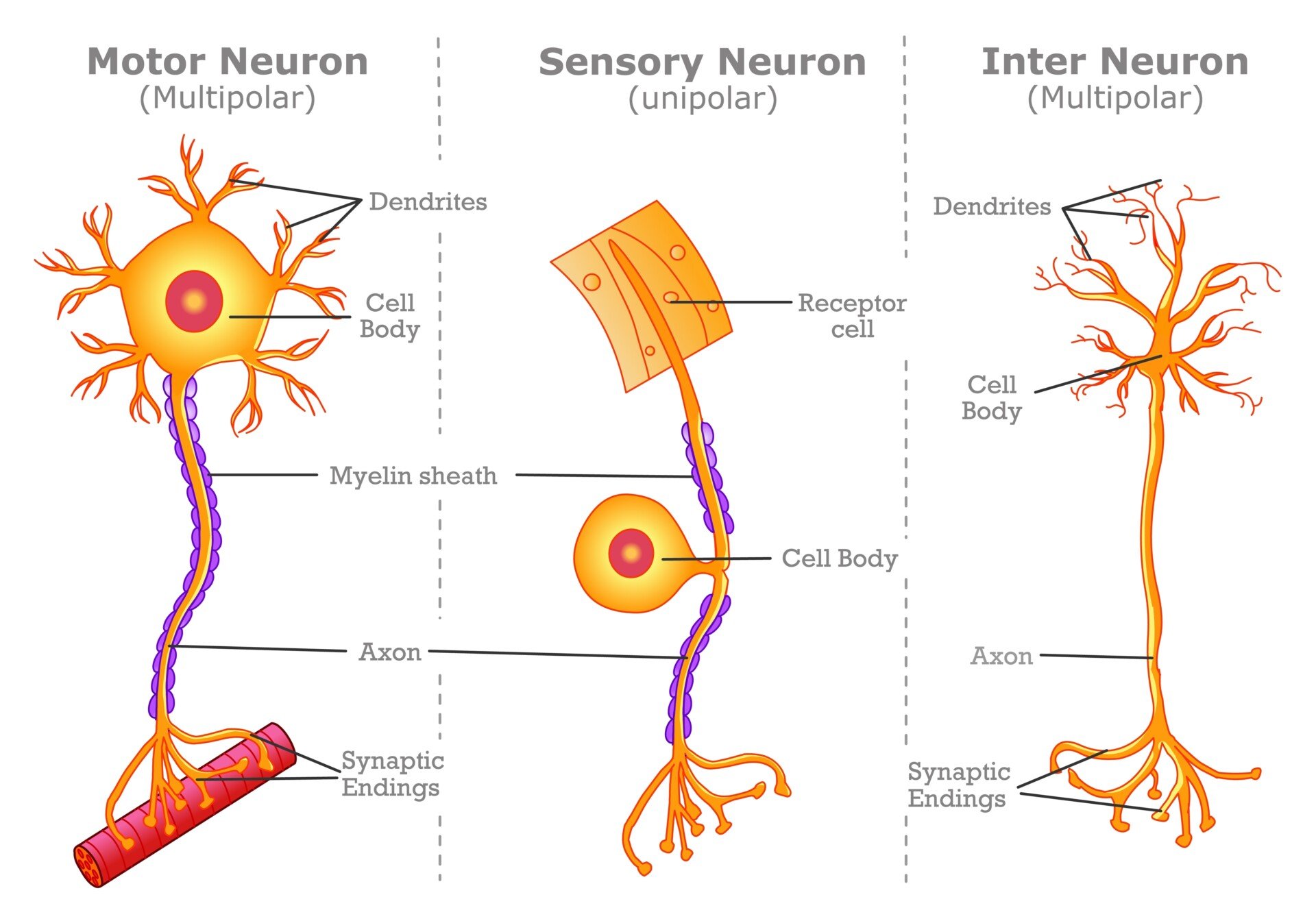Interneurons (also known as relay neurons) are specialized nerve cells that primarily serve as connectors within the central nervous system (CNS). Their unique role is to facilitate communication between other neurons.
Their main job is to connect other neurons—usually linking sensory neurons (which detect stimuli) with motor neurons (which trigger movement), or forming networks within the brain that handle complex processing.

They are incredibly numerous—making up around 20–30% of all neurons in the cerebral cortex—and are essential for keeping brain activity balanced and coordinated.
For example, in spinal reflexes, interneurons in the spinal cord connect sensory neurons, which bring information into the CNS, with motor neurons, which send commands out, allowing for immediate, automatic responses without direct brain involvement.
What do interneurons do?
Below are some of the main functions of interneurons:
Relaying signals
Interneurons are vital for relaying messages, especially in quick, automatic responses like reflex arcs.
For example, in a withdrawal reflex, sensory neurons bring information (e.g., from touching a hot stove) into the spinal cord, where interneurons directly connect them to motor neurons.
This allows for immediate action without conscious brain involvement, saving crucial seconds. Similarly, in the visual system, rods and cones are connected to retinal ganglion cells via interneurons.
Processing information
Within the brain, interneurons are deeply involved in integrating sensory input and higher-level signals.
They process vast streams of information from our senses, emotions, and memories, helping the brain to form coherent thoughts, perceptions, and plans.
This integrative function is fundamental to how we make sense of our environment and interpret complex information.
Modulation
Interneurons play a significant role in modulating neural signals by determining whether a message is excitatory or inhibitory.
An excitatory signal makes a receiving neuron more likely to fire, while an inhibitory signal decreases this likelihood.
This delicate balance, often mediated by neurotransmitters like dopamine (excitatory) and GABA (inhibitory), allows for precise control of brain activity, preventing overstimulation or ensuring appropriate responses.
Cognitive Control
These connector cells are fundamental to higher cognitive functions such as learning, memory, and decision-making.
They facilitate the complex interactions between neurons necessary for forming new memories, engaging in problem-solving, and executing executive control processes like planning and judgment, particularly within areas like the frontal and prefrontal cortex.
Types of Interneurons
Interneurons are incredibly diverse. They can be grouped by:
1. Neurotransmitter Type
Most are GABAergic, meaning they use GABA to inhibit other neurons. Others use glycine, acetylcholine, or glutamate.
Quick Guide: What Are These Neurotransmitters?
- GABA (Gamma-Aminobutyric Acid): The brain’s main inhibitory neurotransmitter. It helps calm activity and prevent overstimulation.
- Glycine: Another inhibitory neurotransmitter, mainly active in the spinal cord and brainstem.
- Acetylcholine: Often involved in attention and learning. It can excite or inhibit neurons depending on the receptor.
- Glutamate: The brain’s main excitatory neurotransmitter. It plays a key role in learning, memory, and brain development.
2. Molecular Markers
In the cortex, most fall into three major groups:
- Parvalbumin (PV): Fast-spiking cells that tightly control timing.
- Somatostatin (SST): Cells that target dendrites and regulate incoming signals.
- Vasoactive intestinal peptide (VIP): Cells that inhibit other interneurons, creating a “disinhibitory” effect.
3. Shape and Structure
Some classic examples:
- Basket cells: Wrap around the bodies of other neurons.
- Chandelier cells: Target axon initial segments, where electrical signals begin.
- Martinotti cells: Send axons to the outer layers of the cortex.
Each type plays a distinct role, often targeting specific parts of nearby neurons.
Development and Plasticity
Unlike excitatory neurons, which are born in the cortex, interneurons are generated elsewhere (in the ganglionic eminences) and then migrate long distances into the cortex during development.
Once in place, they:
- Integrate into circuits by forming synapses with excitatory neurons and other interneurons.
- Mature gradually, often helping open or close critical periods for learning.
Even in adulthood, interneurons remain plastic. Their connections can strengthen or weaken in response to experience, helping the brain adapt to new learning or injury.
Interneurons and Mental Health
Disruption in interneuron function can lead to circuit imbalances linked to several psychological and neurological conditions:
- Schizophrenia: Reduced activity in parvalbumin (PV) interneurons, especially in the prefrontal cortex, is associated with impaired cognitive function and disrupted gamma oscillations. These deficits may contribute to issues with attention and working memory.
- Autism Spectrum Disorder (ASD): Reduced interneuron activity, particularly involving GABA signaling, may contribute to sensory overload and difficulty with information processing, which may explain some signs of autism.
- Epilepsy: Interneuron loss or dysfunction reduces inhibition in seizure-prone areas, leading to hyperexcitability.
- Other Disorders: Interneurons are also implicated in anxiety, depression, Alzheimer’s disease, and Parkinson’s disease. In these conditions, disrupted inhibitory balance may affect fear regulation, mood, memory, and motor control.
Because interneurons are key to neural balance and coordination, they are central to research on brain disorders and treatment development.
Interneurons vs Sensory and Motor Neurons
Below is how to know the difference between these types of neurons:
- Sensory Neurons (Afferent): These neurons carry sensory information from the body’s periphery (like receptor cells in our five senses) to the central nervous system (CNS), which includes the brain and spinal cord. They “arrive” with information.
- Motor Neurons (Efferent): These neurons transmit commands from the CNS to the muscles and glands, dictating how the body should respond. They cause an “exit” of commands.
- Interneurons: These are primarily found within the CNS (brain and spinal cord) and act as connectors. They link sensory neurons to motor neurons, and facilitate communication between other neurons for processing and modulation of signals.
Each type plays a distinct role in the nervous system’s communication network.


